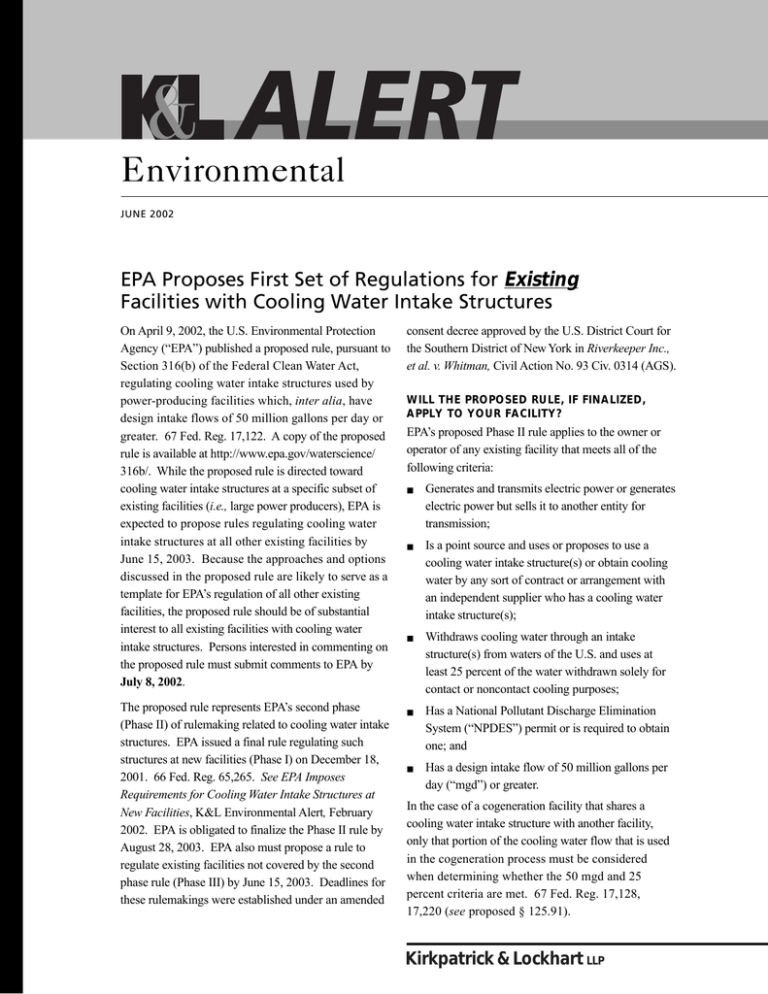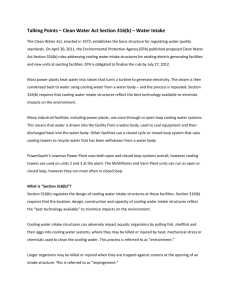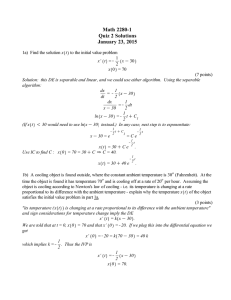
Environmental
JUNE 2002
EPA Proposes First Set of Regulations for Existing
Facilities with Cooling Water Intake Structures
On April 9, 2002, the U.S. Environmental Protection
Agency (“EPA”) published a proposed rule, pursuant to
Section 316(b) of the Federal Clean Water Act,
regulating cooling water intake structures used by
power-producing facilities which, inter alia, have
design intake flows of 50 million gallons per day or
greater. 67 Fed. Reg. 17,122. A copy of the proposed
rule is available at http://www.epa.gov/waterscience/
316b/. While the proposed rule is directed toward
cooling water intake structures at a specific subset of
existing facilities (i.e., large power producers), EPA is
expected to propose rules regulating cooling water
intake structures at all other existing facilities by
June 15, 2003. Because the approaches and options
discussed in the proposed rule are likely to serve as a
template for EPA’s regulation of all other existing
facilities, the proposed rule should be of substantial
interest to all existing facilities with cooling water
intake structures. Persons interested in commenting on
the proposed rule must submit comments to EPA by
July 8, 2002.
The proposed rule represents EPA’s second phase
(Phase II) of rulemaking related to cooling water intake
structures. EPA issued a final rule regulating such
structures at new facilities (Phase I) on December 18,
2001. 66 Fed. Reg. 65,265. See EPA Imposes
Requirements for Cooling Water Intake Structures at
New Facilities, K&L Environmental Alert, February
2002. EPA is obligated to finalize the Phase II rule by
August 28, 2003. EPA also must propose a rule to
regulate existing facilities not covered by the second
phase rule (Phase III) by June 15, 2003. Deadlines for
these rulemakings were established under an amended
consent decree approved by the U.S. District Court for
the Southern District of New York in Riverkeeper Inc.,
et al. v. Whitman, Civil Action No. 93 Civ. 0314 (AGS).
WILL THE PROPOSED RULE, IF FINALIZED,
APPLY TO YOUR FACILITY?
EPA’s proposed Phase II rule applies to the owner or
operator of any existing facility that meets all of the
following criteria:
■
Generates and transmits electric power or generates
electric power but sells it to another entity for
transmission;
■
Is a point source and uses or proposes to use a
cooling water intake structure(s) or obtain cooling
water by any sort of contract or arrangement with
an independent supplier who has a cooling water
intake structure(s);
■
Withdraws cooling water through an intake
structure(s) from waters of the U.S. and uses at
least 25 percent of the water withdrawn solely for
contact or noncontact cooling purposes;
■
Has a National Pollutant Discharge Elimination
System (“NPDES”) permit or is required to obtain
one; and
■
Has a design intake flow of 50 million gallons per
day (“mgd”) or greater.
In the case of a cogeneration facility that shares a
cooling water intake structure with another facility,
only that portion of the cooling water flow that is used
in the cogeneration process must be considered
when determining whether the 50 mgd and 25
percent criteria are met. 67 Fed. Reg. 17,128,
17,220 (see proposed § 125.91).
Kirkpatrick & Lockhart LLP
WHAT IS A COOLING WATER INTAKE STRUCTURE?
EPA defined the term “cooling water intake structure”
in its final regulations for new facilities issued on
December 18, 2001. See 66 Fed. Reg. at 65,339 (new
40 C.F.R. § 125.83). The definition also applies to this
proposed rule. The term is defined as the “total
physical structure and any associated constructed
waterways used to withdraw cooling water from waters
of the U.S.” Id. The cooling water intake structure
“extends from the point at which water is withdrawn
from the surface water source up to, and including, the
intake pumps.” Id.
“Cooling water” under EPA’s earlier final rule and
under this proposed rule is defined as “water used for
contact or noncontact cooling, including water used for
equipment cooling, evaporative cooling tower makeup,
and dilution of effluent heat content.” The definition
further explains that the “intended use” of “cooling
water” is “to absorb waste heat rejected from the
process or processes used, or from auxiliary operations
on the facility’s premises.” 40 C.F.R. § 125.83; 67 Fed.
Reg. 17,219.
WHEN WILL THE PROPOSED RULE, IF
FINALIZED, APPLY?
Facilities obtaining or renewing NPDES permits after
the effective date of the final rule will be obligated to
comply with the requirements in the rule. The
proposed rule specifies the data requirements to support
such an application (see discussion below). Substantial
lead-time may be needed to collect the required data.
As noted above, EPA is required by the consent decree
to issue a final Phase II rule by August 28, 2003. The
final rule likely will become effective some time after
issuance (e.g., the Phase I rule became effective 30
days after issuance). As permits are sought or renewed
following issuance of the final rule, covered facilities
will be required to comply with the new requirements
for their cooling water intake structures.
WHAT WILL THE PROPOSED RULE, IF
FINALIZED, REQUIRE YOU TO DO?
EPA’s proposed Phase II rule establishes national
minimum performance requirements for the location,
design, construction, and capacity of cooling water
intake structures at existing facilities that meet the
applicability criteria above. The purpose of these
requirements is to establish the best technology
available for minimizing adverse environmental impact
2
associated with the use of cooling water intake
structures. See 67 Fed. Reg. 17,220 (see proposed
§ 125.90(a)).
Under the proposed rule, the following three options are
available for demonstrating that the best technology
available has been achieved at your facility:
1. Demonstrate that your existing facility has achieved
“performance standards” established under the
proposed rule – i.e., that your facility has either
(1) reduced intake capacity to a level commensurate
with the use of a closed-cycle, recirculating cooling
system or (2) achieved applicable reductions in
impingement and entrainment mortality;
2. Demonstrate that you have selected measures that
will, in combination with existing measures at your
facility, achieve the “performance standards;”
3. Obtain a site-specific determination of the best
technology available for your facility by
demonstrating either (1) that the costs of complying
with the applicable performance standards under the
rule would be significantly greater for you than the
costs considered by EPA or (2) that the costs of
complying would be significantly greater than the
benefits that would be achieved at your site.
See 67 Fed. Reg. 17,221 (see proposed § 125.94(a),
(b) and (c)).
If you elect one of the first two options and your facility
cannot reduce intake capacity to a level commensurate
with the use of a closed-cycle, recirculating cooling
system, you would need to achieve specific performance
standards applicable to your facility. All facilities are
required to reduce impingement mortality of all life
stages of fish and shellfish by 80 to 95 percent from the
calculation baseline. Id. (see proposed § 125.94(b)).
This is the only standard you would need to achieve if
your facility:
(1) has a capacity utilization rate of less than 15 percent;
(2) has a design intake flow of five percent or less of the
mean annual flow from a freshwater river or stream;
or
(3) withdraws cooling water from a lake other than one
of the Great Lakes.
Id. (see § 125.94(b) and (c)). All other facilities also
would be required to reduce entrainment of all life stages
of fish and shellfish by 60 to 90 percent from the
calculation baseline. Id. Finally, if you withdraw
KIRKPATRICK & LOCKHART LLP ENVIRONMENTAL ALERT
cooling water from a lake other than one of the Great
Lakes and propose to increase your facility’s design
intake flow, you would be required to ensure that your
increased flow will not disrupt the natural thermal
stratification or turnover pattern (where present) of the
source water, except in cases where the disruption has
been determined to be beneficial by the appropriate
fish or wildlife management agency(ies). Id.
(see § 125.94(c)).
Under the site-specific option (the third option noted
above), you would need to present data specific to your
facility that demonstrates that your costs of complying
with the performance standards would be significantly
greater than the costs considered by EPA in developing
the rule or the benefits that would be achieved at your
site. Id. (see § 125.94(c)). A site-specific
determination of best technology available for
minimizing adverse environmental impact based on
less costly design and construction technologies,
operational measures, and/or restoration measures
could be made for your facility to the extent justified.
Id. Site-specific determinations may conclude that
measures in addition to those already in place are not
justified because of significantly greater costs. Id.
As an alternative to the above requirements, the
proposed rule also offers the opportunity to use
restoration measures that increase fish and shellfish
within the water body in lieu of measures to reduce
impingement and entrainment. Id. (see proposed
§ 125.94(d)). To obtain approval to use this approach,
you would need to demonstrate that you are
maintaining the fish and shellfish, including
community structure and function, within the water
body from which you are withdrawing water to a level
comparable to those that would result if you were to
employ design and construction technologies or
operational measures otherwise required under the
proposed rule. Id.
WHAT INFORMATION WILL BE REQUIRED AS
PART OF YOUR PERMIT APPLICATION UNDER
THE PROPOSED RULE, IF FINALIZED?
If covered by the proposed rule, you would be required
to submit the additional information required as part of
your NPDES permit renewal application at least 180
days before your existing permit expires. If this rule is
finalized after you have submitted an application for
permit renewal, but before you have received your
JUNE 2002
renewed permit, you may be required to supplement
your permit application to provide the additional
information required under the final rule. Likewise, if
you are submitting a new application for a permit and
have not received your permit before the final rule
becomes effective, you may be required to provide the
additional information required under the final rule.
The proposed rule requires submission of a
Comprehensive Demonstration Study as part of the
permit application for all facilities covered by the rule
except those that reduce their intake capacity to a level
commensurate with the use of a closed-cycle,
recirculating cooling system. See 67 Fed. Reg. 17,222
(see proposed § 125.95(b)). The study must include
the following categories of information:
(1) Proposal for information collection;
(2) Source water body flow information;
(3) Impingement mortality and entrainment
characterization study;
(4) Design and construction technology plan;
(5) Information to support proposed restoration
measures; and
(6) Verification monitoring plan.
Id. The specific information that must be included in
each of these categories is outlined in the proposed
rule. These requirements should be reviewed carefully
as you may need to begin efforts to collect this
information well in advance of the date that your
permit renewal application is due.
WHAT OTHER APPROACHES IS EPA
CONSIDERING?
Although the requirements outlined above are those
preferred by EPA in its proposed rule, EPA also is
seeking comments on several other alternative
approaches to regulate cooling water intake structures.
Other technology-based options under consideration
include:
(1) Requiring intake capacity to be commensurate with
closed-cycle, recirculating cooling systems for all
facilities (67 Fed. Reg. 17,154 (see Section B.1));
(2) Requiring intake capacity to be commensurate
with closed-cycle, recirculating cooling systems
based on water body type (67 Fed. Reg. 17,155
(see Section B.2));
(3) Requiring intake capacity to be commensurate with
Kirkpatrick & Lockhart LLP
closed-cycle, recirculating cooling systems based
on water body type and proportion of water body
flow (67 Fed. Reg. 17,156 (see Section B.3; sample
alternate regulatory language is provided); and
(4) Requiring impingement mortality and entrainment
controls everywhere (67 Fed. Reg. 17,158 (see
Section B.4)).
EPA also is considering a site-specific option based on
the view that the location of each power plant and the
associated intake structure design, construction, and
capacity are unique, and that the optimal combination
of measures to reflect best technology available for
minimizing adverse environmental impact should be
determined on a case-by-case basis. See 67 Fed.
Reg. 17,159 (see Section C.; sample alternative
regulatory language is provided.)
and potential facility improvements that may be
required, particularly if your facility will apply for a
NPDES permit or permit renewal in 2003 when the rule
is expected to be finalized. You also may submit
comments on the rule proposed by EPA and the
suggested alternatives any time before July 8, 2002.
If your facility potentially will be covered by EPA’s
Phase III rule, you also should evaluate and consider
commenting on the proposed Phase II requirements and
suggested alternatives, as the Phase II requirements are
expected to serve as a model for the Phase III rule.
Although EPA is not expected to propose Phase III
rules until as late as June 2003, Phase III facilities may
be affected substantially by the outcome of the debate
over the Phase II requirements.
KIMBERLY A. HUMMEL
CONCLUSION
khummel@kl.com
717.231.4807
If your facility would be covered by EPA’s proposed
Phase II rule, you should evaluate closely the Phase II
requirements that may apply at the time of your next
NPDES permit application. It is not too early to begin
to plan for the data collection and study requirements
CRAIG P. WILSON
cwilson@kl.com
717.231.4509
FOR MORE INFORMATION about this Alert, Kirkpatrick & Lockhart’s environmental practice
or criminal enforcement of environmental laws, please contact the authors or one of the K&L office
contacts below. You may also visit our webpage at www.kl.com/PracticeAreas/Environmental.
Roger C. Zehntner
Stephen A. Kennedy
Joel R. Burcat
Frederick J. Ufkes
Daniel A. Casey
Anthony P. La Rocco
Warren H. Colodner
Richard W. Hosking
Edward P. Sangster
Barry M. Hartman
Boston
Dallas
Harrisburg
Los Angeles
Miami
Newark
New York
Pittsburgh
San Francisco
Washington
617.261.3149
214.939.4917
717.231.4518
310.552.5079
305.539.3324
973.848.4014
212.536.3912
412.355.8612
415.249.1028
202.778.9338
rzehntner@kl.com
skennedy@kl.com
jburcat@kl.com
fufkes@kl.com
dcasey@kl.com
alarocco@kl.com
wcolodner@kl.com
rhosking@kl.com
esangster@kl.com
bhartman@kl.com
®
Kirkpatrick & Lockhart LLP
Challenge us. ®
www.kl.com
BOSTON
■
DALLAS
■
HARRISBURG
■
LOS ANGELES
■
MIAMI
■
NEWARK
■
NEW YORK
■
PITTSBURGH
■
SAN FRANCISCO
■
WASHINGTON
.........................................................................................................................................................
This publication/newsletter is for informational purposes and does not contain or convey legal advice. The information herein
should not be used or relied upon in regard to any particular facts or circumstances
without&first
consulting
lawyer.
KIRKPATRICK
LOCKHART
LLPaENVIRONMENTAL
ALERT
4
© 2002 KIRKPATRICK & LOCKHART LLP.
ALL RIGHTS RESERVED.






